Building Allegiances, Part 1
It's the start of Ravnica Allegiance previews. So, I'm going to walk you through the set's design and show off some cards (including the completion of a number of cycles you're already aware of). The one thing I'm going to do a little differently from past preview articles is go a little more in depth on some of the mechanics that we didn't end up using. In the past, I've always been a bit shy in talking about mechanics we didn't use out of a concern that they might seem less exciting if we ever do them later, but through a bunch of interactions on my blog, I've come around to the idea that you'll still be excited by a mechanic even if you've heard about it before. The futureshifted cards from Future Sight, for example, were us telegraphing future mechanics, and that only made all of you want to see them in print even more. By being a bit more open, I'll be able to let you have a better glimpse into our behind-the-scenes processes. That said, on with the article.
Normally, I would start this column by introducing you to my Design team, but I did that during the first week of Guilds of Ravnica previews (here, if you haven't seen it) as both of these Ravnica sets had a shared Vision Design team. That team, for those that don't remember and/or don't want to hit the link, was Jules Robins, Jackie Lee, Ari Levitch, Sam Stoddard, Bryan Hawley, and myself.
Ravnica Allegiance had two basic goals—one, make a mirrored set to Guilds of Ravnica, completing all the ten-card cycles that we ran through all the guilds, and two, create new mechanics for each of the five other guilds (the Azorius Senate, Cult of Rakdos, Gruul Clans, Orzhov Syndicate, and Simic Combine). Let me start with the first goal.
A big part of making a multicolored set work is having the right amount of mana fixing. We ended up with three cycles: one that we had first done in original Ravnica block, one that we had started in Return to Ravnica block, and one that we started in Guilds of Ravnica.
That means we begin with the "shock lands."
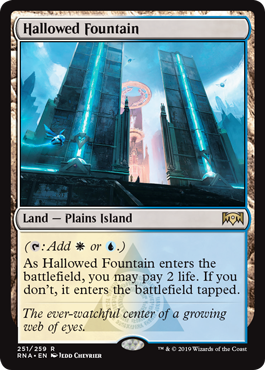
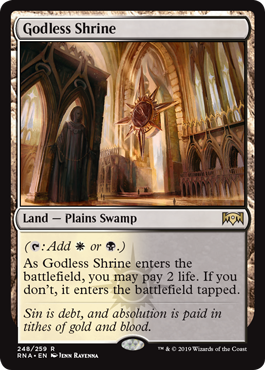
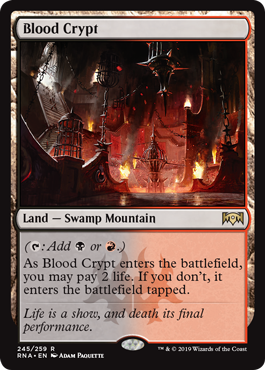
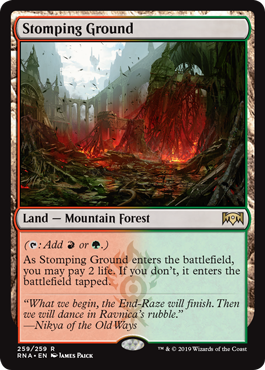
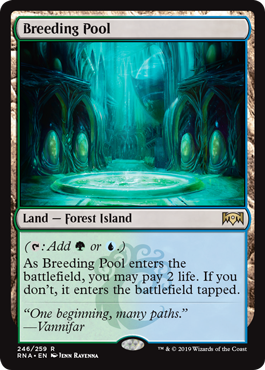
I designed this cycle for original Ravnica with the goal of finding lands that were a cross between pain lands (aka the dual lands from Ice Age and Apocalypse that damage you when you tap them) and tap lands (aka the dual lands from Invasion, and later Shadows over Innistrad, that come into play tapped). My goal with the pain land part was to front-load the life loss so that there weren't any tracking issues. I gave the lands the basic lands types because we hadn't done a lot of dual lands with basic land types and I thought there would be some fun synergy with them. (Turns out I was correct.)
R&D's initial thoughts were that the lands were too complicated, but I argued that the various components all mentally chunked together with a simple question—do you want this dual land to enter the battlefield tapped or untapped? If yes, there was a small one-time cost. R&D eventually came around, and the lands got printed. I asked that the lands get non-plane specific names because I felt the lands were the kind of thing we might want to use in other sets. (Ironically, since their creation, they have yet to show up on a world other than Ravnica.) Interestingly, for both Return to Ravnica and Guilds of Ravnica, we discussed not including the shock lands (usually suggesting they come out in sets the year before the Ravnica sets), but, in each case, we came around to including them.
Next are the Guildgates:
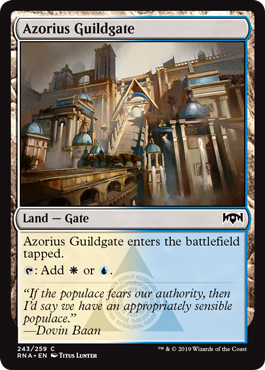
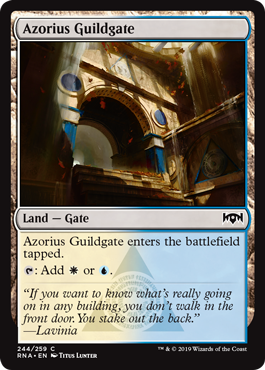
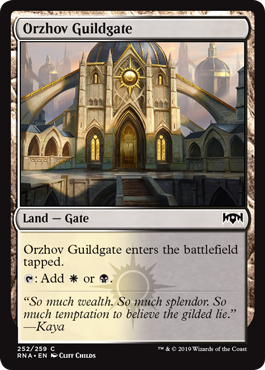
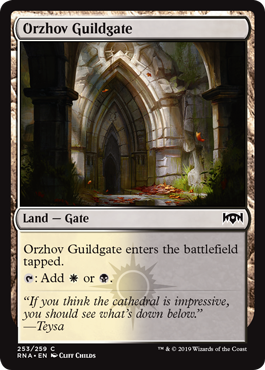



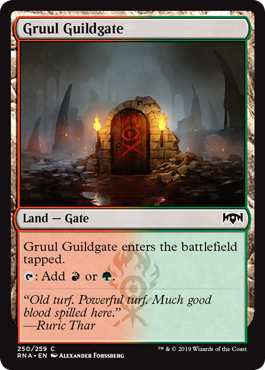
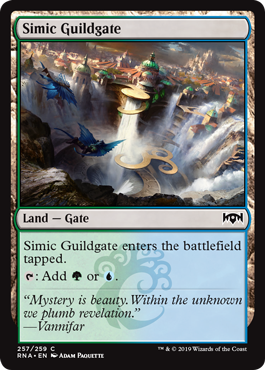
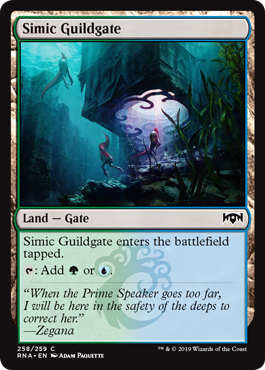
The Guildgates were created in Return to Ravnica because we were interested in having a cycle of common dual lands. The obvious choice was the tap lands, but it felt odd as the "shock lands" were strictly better versions. We do have the occasional strictly better card in a set at a higher rarity, but having a whole cycle felt more egregious, so we wanted to find an extra something we could add to the tap lands. We explored life gain, opponent life loss, and various other small bonuses, but most ended up feeling more uncommon than common.
The solution came when the Creative team asked if we could have lands that represented the different gates of the guilds as it was part of the larger story. The common dual lands felt like the right place to do this, so we ended up with the idea of giving the lands a Gate subtype. In a vacuum, they were the tap lands, but we could make cards that flavorfully cared about you having Gates. This would allow us to keep the common dual lands simple while adding another layer to the gameplay. We started Guilds of Ravnica vision design assuming the Guildgates would return (we did end up raising the number of cards that mechanically cared about Gates in each set).
And we come to the final cycle, the Lockets:
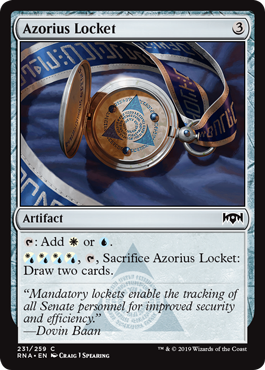
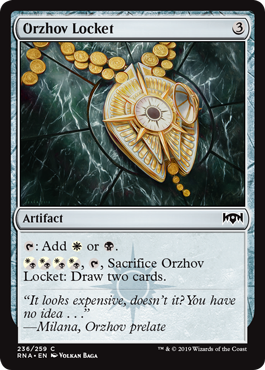
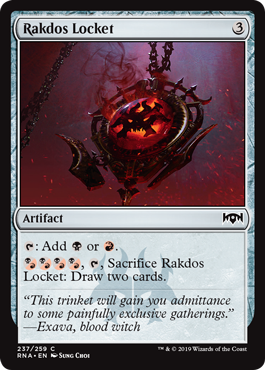
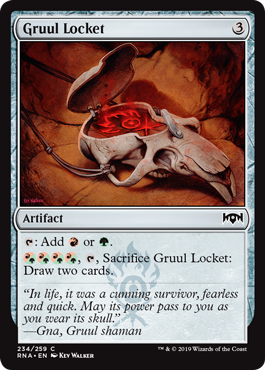
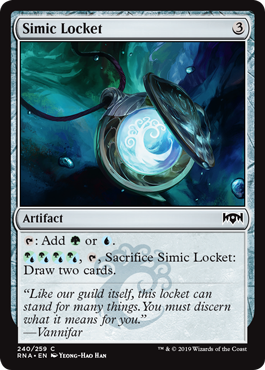
One of the challenges with color-fixing in Ravnica sets is doing so while not making it too easy to just play all five colors. How could we make a cycle of color-fixers that pushed you to play two colors? In Dragon's Maze we'd made the Cluestones, three-mana artifacts that tapped for one of two colors and then could be traded in for a card using one mana of each of the two colors. We were interested in making a tweaked version of the Cluestones. The answer we ended up with was using hybrid mana, something that had been introduced in original Ravnica block and used in every Ravnica set. Instead of two mana to draw one card, the Lockets let you use four mana (all hybrid) to draw two cards.
With that out of the way, let's start talking guild mechanics. Normally, I go in the order that we use for collector numbers (Azorius, Dimir, Rakdos, Gruul, Selesnya, Orzhov, Izzet, Golgari, Boros, Simic) which is every ally pair going in WUBRG order starting with the mana symbol printed first through every enemy-color pair ordered the same way. For Ravnica Allegiance, that would mean: Azorius, Rakdos, Gruul, Orzhov, Simic. I've decided instead today to go backward, for two reasons. One, as someone with a name appearing later alphabetically, I know the unfairness of always going in the set order. Two, my preview card is a Simic card, and I need to get to it today.
Simic
The first thing I did when we started the joint Guilds of Ravnica-Ravnica Allegiance vision design was to make a list of every existing keyword mechanic and ability word that felt appropriate for any of the ten guilds.
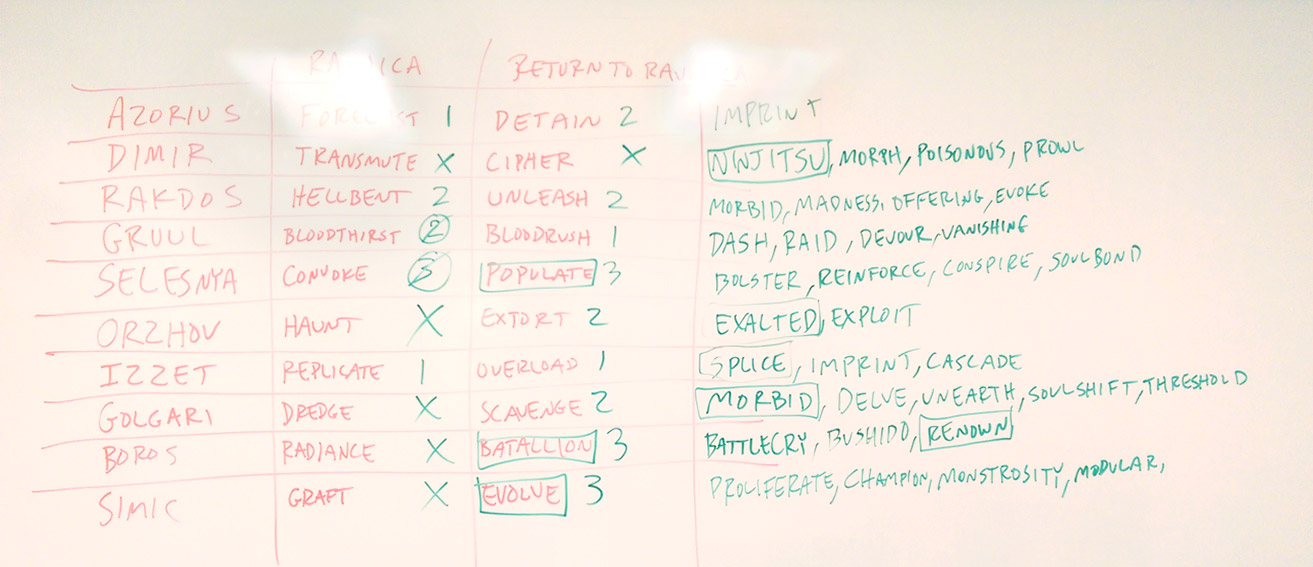
One of the slam-dunk obvious ones was proliferate for Simic.
Proliferate was originally created in Scars of Mirrodin as a way to express the viral nature of the Phyrexians and further play into the "Phyrexians as disease" metaphor that we were going for. The open-endedness of the mechanic, along with the joyful gameplay, made it very popular. So much so that I was intent on bringing it back, ideally in a set without -1/-1 counters or poison, so it would play differently from its first appearance.
Kaladesh seemed like the perfect set to bring it back. The set had both energy (which used energy counters) and a +1/+1 counter theme (including the fabricate mechanic). The differential between energy counters and +1/+1 counters proved to be too great and forced us to unfortunately remove it in vision design. The Aether Revolt Design team picked up the ball and tried a second time to make proliferate work, also, sadly, to no avail.
The Simic were mostly focused on +1/+1 counters, so we were hopeful that this time we could make it work. In fact, while we experimented with other things, Vision Design's official handoff to Set Design was proliferate. So, what happened? One of the requirements of a guild set is that there's synergy between the guilds that overlap in color. For Simic, in this set, that meant Azorius and Gruul. In the Vision Design handoff, neither of those two guilds made use of a counter in their guild mechanic. We offset this by making individual card designs that did.
As you'll see next week, Azorius had a mechanic that focused on "enters-the-battlefield" effects. We just made sure a number of them added +1/+1 counters (mostly to itself in blue; white was able to add them to other creatures). Gruul also used its mechanic to add +1/+1 counters to itself. Gruul's mechanic got moved to Rakdos (more on that next week) and the new mechanic the Set Design team created involved +1/+1 counters. That's great, right? More synergy. The problem was it was a little too synergistic. Just as Guilds of Ravnica had the issue of making sure Boros and Selesnya weren't too synergistic, so too did Simic and Gruul.
In the end, it was decided that proliferate just makes a poor guild mechanic as it requires a lot of fine-tuning to the environment to properly balance it, and Ravnica sets already have many other balance issues going on. Proliferate was too hard a mechanic to interlock with other guilds and set up in a way where the players could have fun playing it. The last thing we wanted to do is bring it back and not have players enjoy the kinds of cards we'd be able to make. That meant proliferate got pushed off
This meant the Set Design team needed to find a different mechanic for Simic. While they examined some new mechanics, they also looked at old mechanics. Simic, in particular, had a lot of synergy with existing keywords. After much searching, that centered on monstrosity.
Monstrosity was created in Theros to address the flavor of monsters. The set was a top-down Greek mythology–inspired set, and we'd focused the set early on to be about Gods, heroes, and monsters. To capture the mythological flavor, the set had a buildup motif that ran through its entirety. Gods were tied to enchantments, and the bestow mechanic allowed you to pack your deck full of Auras to make your creatures bigger. The Gods also had the devotion mechanic, which rose in strength as you got more of the appropriate colored permanents on the battlefield.
The heroes were tied to the heroic mechanic that rewarded you for targeting your creatures, often making them bigger. We likewise wanted a way for monsters to grow over time. Monstrosity was our answer. Monsters had a one-time upgrade which would make them bigger and often grant them other abilities. The mechanic originally had a "use once per game" restriction, but it was later changed to reference if creatures were "monstrous," which meant the ability had been used. As that always created some number of +1/+1 counters, we used the counters as a memory aide. To make it clear that those counters were created by a monstrosity effect rather than some other means, we severely cut down the ways in Theros block to put +1/+1 counters onto other creatures. The set mostly gave creatures ways to put +1/+1 counters on themselves.
Monstrosity was used in Theros. We removed it from Born of the Gods to make way for other mechanics. In Journey into Nyx, we realized the error of our ways and brought monstrosity back. That's the only time (to my memory) that we used a named keyword mechanic in the first and third sets in a block and not the second. Monstrosity would later be used in Commander (2015 Edition) and Conspiracy: Take the Crown.
The Set Design team liked monstrosity, but there were a couple of problems. One was the +1/+1 counter issue. Simic was a guild centered on generating +1/+1 counters. Having the restriction that it couldn't put +1/+1 counters onto other creatures just fought against how the guild wanted to work. The second problem was the name monstrosity. While other members of Ravnica might see the Simic's creations as monsters, the Simic didn't. It didn't feel right using a word that the guild wouldn't use about itself.
The solution to this problem was to tweak the mechanic, which would also allow us to change its name. Monstrosity became adapt. Now, instead of caring if the creature was "monstrous" (aka whether the ability had been activated), it now just looks for whether there's +1/+1 counters on the creature. This creates two new interactions. One, if you remove the counters from the creature, you're allowed to activate adapt again, and two, if you can somehow get +1/+1 counters onto an adapt creature, you can prevent it from using the ability. And that is how adapt came to be the Simic mechanic.
Before moving on, I have a preview card to show you. While it doesn't use adapt, it very much plays into Simic's themes. Without further ado, I'd like to formally introduce you to the Hydroid Krasis.
Click here to meet Hydroid Krasis
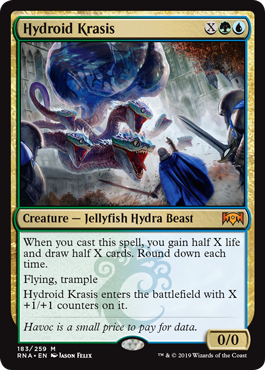
To all the Simic fans out there, I hope you enjoy your new Jellyfish Hydra Beast.
Orzhov
The mechanic Vision Design handed off for Orzhov was called "debt." Here's how it worked. Certain spells would give debt counters to your opponent. At the beginning of their end step, they could get rid of any number of debt counters by paying 1 mana per debt counter. Then, as long as they had any debt counters remaining, they lost 1 life (not per debt counter just 1 life total regardless of how many debt counters they had). The way it tended to play was that players ignored the debt counters early in the game as they wanted to maximize using their mana. Then, as the debt slowly accumulated, they had to start paying it off, as the continual life loss was starting to become a problem, but often they couldn't pay it off at the rate they needed without impacting their game. Players didn't often die to their debt, but the act of paying it off often put them at a severe enough disadvantage that they'd lose the game.
The Set Design team worked very hard to make debt work, but it had a number of problems. One, the mechanic it was most synergistic with, Simic's proliferate, wasn't even in an overlapped color (and it would later leave the set). Two, the knobs available to fine-tune the mechanic weren't very exact. The Set Design team tried various ways to fix this, but never with any great luck. Three, it was a mechanic that worked best in larger numbers. The guild structure likes mechanics that can function as a splash, and debt did a poor job of this. In the end, while debt had great flavor, it just wasn't as functional as the set needed for a guild mechanic.
Set Design then looked for a replacement. Here were the requirements. One, it had to be flavorful and feel like an Orzhov mechanic. Two, it needed to play into Orzhov's attrition-style gameplay. Three, it wanted to overlap with the guilds around it.
To capture the first requirement, the Set Design team talked with the Creative team. What was the essence of what the Orzhov was doing in the story? Orzhov was one of the Bolas-affiliated guilds. Kaya had joined the guild as Bolas's appointed overseer and uses her abilities to sway the guild toward the dragon. Other than that, Orzhov was acting like Orzhov taking advantage of the denizens of Ravnica and leaning into their ability to keep people in debt even after their death.
The team latched onto the idea of creatures that serve you even after their death. What if there was a mechanic that made creatures come back as Spirits after they died? To push in different space than Amonkhet's embalm mechanic, the team liked the idea of making creature tokens and also attaching a number to the ability so that we could adjust how many creature tokens you got. The tokens ended up being 1/1 white and black Spirits with flying, because it was both flavorful and led to good gameplay.
The ability, afterlife, allowed creatures to essentially do double duty as creatures. This played directly into the attrition-style gameplay as it let them block twice and/or be used for sacrifice effects. The creature tokens being 1/1 fliers also helped create small points of damage that Orzhov likes to inflict as it's bleeding out the opponent.
Finally, afterlife played nicely with the guilds overlapping it. Rakdos liked having the evasion as it worked with its guild mechanic (more on this next week), and Azorius liked having fliers as Azorius has built-in affinity with flying creatures. The team spent a little time adjusting the numbers but ended up with a mechanic that hit all three of their requirements.
Guild to Order
That's all the time I have for today. I'll get to the other three guilds (Gruul, Rakdos, and Azorius) next week. (Hopefully, the title gave you a clue this was going to happen.) As always, I'm eager to hear your feedback either on today's column or any of the guilds or mechanics I discussed. You can email me or contact me through any of my social media accounts (Twitter, Tumblr, Google+, and Instagram).
Join me next week for part two.
Until then, may you have fun exploring five more guilds.
#597: Collecting
#597: Collecting
38:00
In this podcast, I talk about an aspect of the game I don't discuss often—collecting. I discuss the many ways we make the game collectible and what impact that has on how we design.
#598: Golgari
#598: Golgari
35:16
This podcast is part of my guild series where I walk through the history of each guild through all three visits to Ravnica. In this podcast, I talk all about the black-green guild, the Golgari Swarm.
- Episode 596 Izzet
- Episode 595 Selesnya
- Episode 594 Dimir

